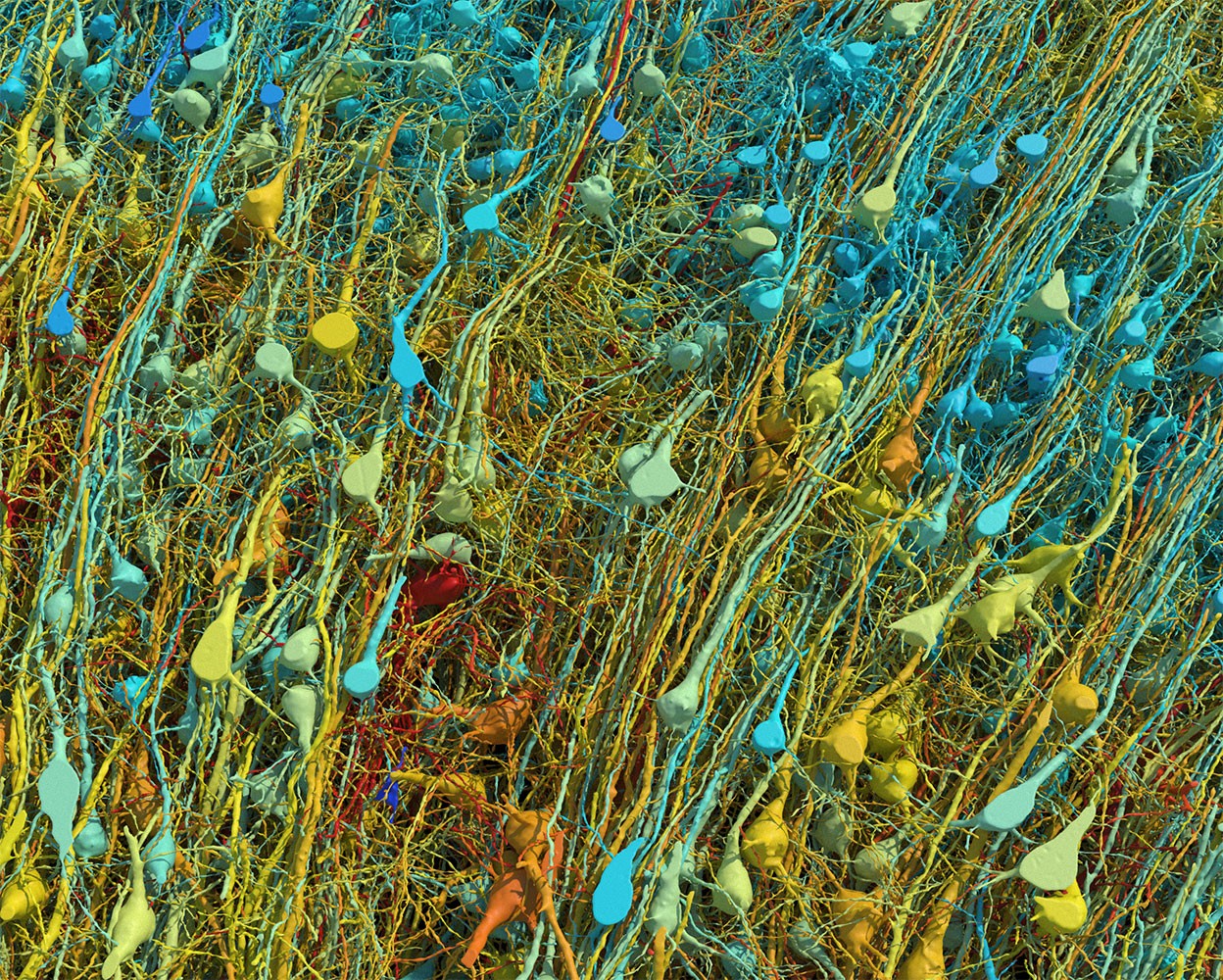Science
Related: About this forumCubic millimetre of brain mapped in spectacular detail
09 May 2024
Cubic millimetre of brain mapped in spectacular detail
Google scientists have modelled a fragment of the human brain at nanoscale resolution, revealing cells with previously undiscovered features.
By Carissa Wong

Rendering based on electron-microscope data, showing the positions of neurons in a fragment of the brain cortex. Neurons are coloured according to size. Credit: Google Research & Lichtman Lab (Harvard University). Renderings by D. Berger (Harvard University)
Researchers have mapped a tiny piece of the human brain in astonishing detail. The resulting cell atlas, which was described today in Science1 and is available online, reveals new patterns of connections between brain cells called neurons, as well as cells that wrap around themselves to form knots, and pairs of neurons that are almost mirror images of each other.
The 3D map covers a volume of about one cubic millimetre, one-millionth of a whole brain, and contains roughly 57,000 cells and 150 million synapses — the connections between neurons. It incorporates a colossal 1.4 petabytes of data. “It’s a little bit humbling,” says Viren Jain, a neuroscientist at Google in Mountain View, California, and a co-author of the paper. “How are we ever going to really come to terms with all this complexity?”
Slivers of brain
The brain fragment was taken from a 45-year-old woman when she underwent surgery to treat her epilepsy. It came from the cortex, a part of the brain involved in learning, problem-solving and processing sensory signals. The sample was immersed in preservatives and stained with heavy metals to make the cells easier to see. Neuroscientist Jeff Lichtman at Harvard University in Cambridge, Massachusetts, and his colleagues then cut the sample into around 5,000 slices — each just 34 nanometres thick — that could be imaged using electron microscopes.
Jain’s team then built artificial-intelligence models that were able to stitch the microscope images together to reconstruct the whole sample in 3D. “I remember this moment, going into the map and looking at one individual synapse from this woman’s brain, and then zooming out into these other millions of pixels,” says Jain. “It felt sort of spiritual.”
[...]
doi: https://doi.org/10.1038/d41586-024-01387-9
erronis
(15,543 posts)The complexity of life is astounding.
paleotn
(18,041 posts)Amazing what you can do in 3.7 billion years.
Farmer-Rick
(10,264 posts)There is the excerting force of evolution on it. Evolution is not random; it is based on reproduction of surviving DNA.
But I get your point. It is amazing what can happen in the span of billions of years. We are but a speck in the scheme of the universe.
paleotn
(18,041 posts)Which mutations "take" and which don't are driven by reproductive success and environment, making it look like chance had no part in it.
Most mutations are neither harmful nor beneficial. They can be carried forward into future generations or not. Some mutations are quite harmful and quickly selected out. But occasionally, a chance mutation provides a significant benefit, driving evolutionary change.
But never discount the power of random chance and incredible lengths of time. Look under the hood and that's the engine of evolution. Nothing mystical or directed about it. It just looks that way from the outside.
JohnnyRingo
(18,730 posts)From how they sliced that square mil of brain tissue into so many pieces, to the fact that Google has scientists.
What a world we live in!
Thanx for posting!
FailureToCommunicate
(14,050 posts)BadgerKid
(4,567 posts)
Kick in to the DU tip jar?
This week we're running a special pop-up mini fund drive. From Monday through Friday we're going ad-free for all registered members, and we're asking you to kick in to the DU tip jar to support the site and keep us financially healthy.
As a bonus, making a contribution will allow you to leave kudos for another DU member, and at the end of the week we'll recognize the DUers who you think make this community great.